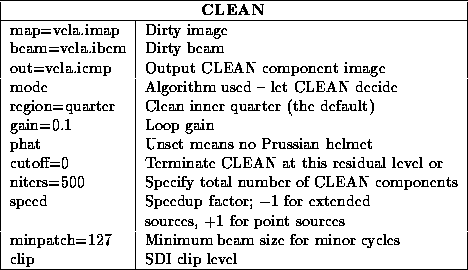mode parameter can be set to indicate the particular
algorithm to use. Possible values are `hogbom', `clark', `steer' or
`any' (the default). With `any', clean
determines what it believes is
the best algorithm for your particular image. In this case, clean
can
switch between different algorithms, as the nature of the residuals change.
This is particularly useful when CLEANing a large image which contains some
strong point sources and much lower brightness extended emission. In this case,
clean
may well switch from a Clark or Högbom algorithm to the SDI
algorithm when it finds that the residuals are becoming very smooth.
Generally you can allow clean to choose the algorithm. Task clean
will override your choice if you attempt to use the Högbom algorithm on an image that is too big.
to limit the CLEAN region to an area one quarter that of the beam, and
to make it fit snugly around the real emission. The
region parameter can be used to describe quite complex CLEANing
regions. See Section 6.3 on how to specify this common
parameter. Alternatively, you can use task cgcurs
to describe
the region interactively from a display of an image on a PGPLOT device.
Task cgcurs
(see Chapter 16.2) produces a text file,
cgcurs.region, describing the region selected, which you can then
input to clean
(see Section 2.5). For example:
region=@cgcurs.regionThe default CLEAN region is the inner quarter of the image.
For very dirty dirty images, you might initially have only a very poor knowledge of where your emission is. In this case, CLEAN can be somewhat iterative. On your first CLEAN, you make an initial estimate of the region containing emission. Having produced a restored image, you then use this to get a better estimate of the region containing emission. You CLEAN again, and so on.
 or so).
Specify this level with the parameter
or so).
Specify this level with the parameter cutoff. Alternatively, you
can tell clean
to stop when it encounters the first
negative component, by using the options=negstop switch. Otherwise,
CLEANing will proceed until niters CLEAN iterations have been
performed. When CLEANing a cube, niters is the number of
iterations per plane. For small and simple sources, a few hundred
iterations are usually sufficient. For complicated and large sources,
you can CLEAN forever.
You can set all three of cutoff, options=negstop and niters. Task clean will stop when any one of these stopping criteria are satisfied.
model parameter to the name of the old output CLEAN component
image, and setting the out parameter to a new name. Actually the
model image need not have been produced by clean
-- it can be
any image with units of Jy/pixel. Of course, it should be a representation of
your source. The model image, however, must align exactly with the
region being CLEANed ( i.e. same pixel increments, and same size as the
bounding box of the selected region).
speed to some small negative number -- typically -1 is good.
The default is 0.
minpatch is the
minimum full width ( not half-width, as it is in AIPS
) of the beam patch
used in the minor cycle. The default is 51. However, for ATCA work, where
the beam can often have large distant sidelobes, and so this value may be too
small.
Setting minpatch to larger values will slow the
algorithm, but may avoid CLEAN striping problems. The maximum value that
clean
will accept is 257 -- larger values will be trimmed back to
257.
clip times the
peak flux density are considered to represent true structure, and so are taken
as components for that iteration. Typically the clip level is 0.9. The
default that clean
computes is image dependent, and will be a
function of how many pixels there are across the beam. The default
value is usually adequate.
- negstop
- Stop CLEANing when the first negative component is encountered.
- positive
- Apply a positivity constraint. This constrains the component image to be non-negative. A side-effect of this is that CLEAN will stop iterating if it cannot continue to ensure this. This does not have any effect with SDI iterations. This option does not seem to produce as much improvement as one might hope.
- asym
- Normally clean assumes that the beam has a 180 degree rotational symmetry, which is the norm in radio interferometry. Making such an assumption allows some optimisations. You should instruct clean if this is not the case, by using the asym switch.
- pad
- Double the beam size by padding it with zeros. This will
give better stability with Clark and Steer modes if you are daring enough
to CLEAN an area which is more than a quarter of the beam area.
